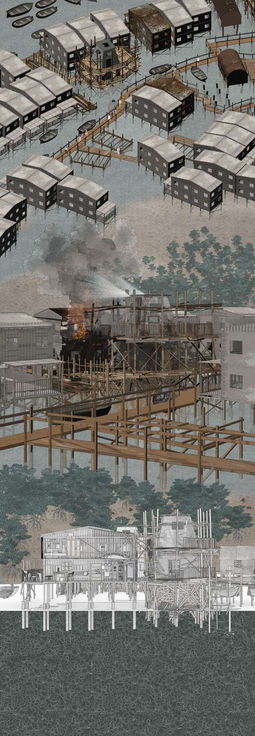Create Your First Project
Start adding your projects to your portfolio. Click on "Manage Projects" to get started
Living Architecture in Tai O
- Project Description
“Through tides and tempests, I endure—not by strength, but by the life woven between my veins and those who shaped me.”
This thesis explores the concept of architectural vitalism, it sees architecture as a living system of materials with their own agency, vitality, and creativity. It explores how architecture can transcend human-centric design, engaging material agency to create spaces that are adaptive, responsive, and collaborative within their environments. Situated in Tai O, Hong Kong’s last fishing settlement, this study focuses on a site where buildings are crafted in an ad-hoc way within designated plots, with wood and human labour collaboratively resisting tidal shifts and natural forces over generations. From traditional fishing villages to modern skyscrapers, water has consistently underpinned Hong Kong’s urban growth, and Tai O, as a vibrant piece of Hong Kong’s cultural heritage, has long attracted tourists. Here, stilt houses function as resilient structures, constructed from tangible materials that evolve with the environment. Over time, these materials have warped, decayed, chipped, and weathered, shaping Tai O’s livelihood, culture, economy, and aquatic ecosystem, contributing significantly to its authenticity.
Despite Tai O’s unique character, the village confronts serious challenges, including deteriorating building structures, limited government funding, and insufficient public facilities. With an aging population and younger residents migrating to urban areas for better educational and job opportunities, Tai O faces a gradual decline. Nonetheless, tourists are still drawn to its authentic representation of old Hong Kong architecture and culture. By adopting the perspective of architectural vitalism, this study seeks to explore how a material-based design system could sustain Tai O’s authenticity while creating economic opportunities. This approach envisions Tai O not as a static relic but as a dynamic environment where human and nonhuman elements interact continuously. Through analyzing the architectural features at various scales, from large to small, this thesis examines the cooperative relationship among human, material, and nonhuman factors in forming architectural assemblages over time. By observing the fluidity of matter across different material scales, this work emphasizes our shared physical existence with our environment and the interconnectedness of all materials around us.
National University of Singapore
Josephine Pun Tsz Kiu











